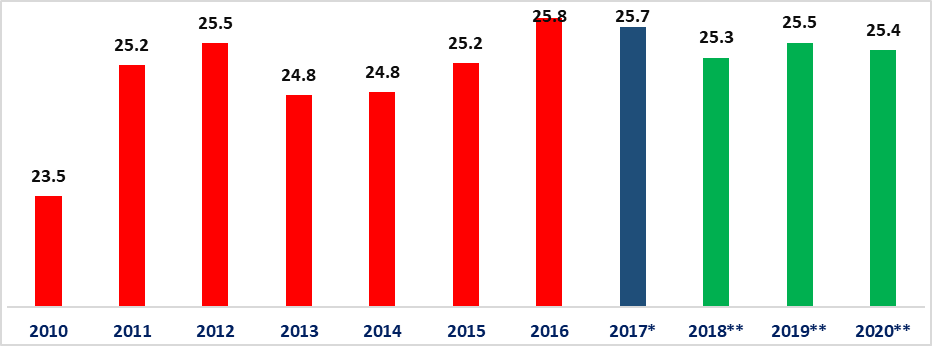On 12 June 2018, the United Nations Children’s Fund published the results of its 2017 Population Well-being Research. In accordance with the research, poverty figures have increased in Georgia in the last two years. The poverty level has increased in every group of the population although the highest growth of poverty was registered among children. The slowly rising economic growth rate and increased consumer prices are the reasons contributing to this increase.
Research on the well-being of the Georgian population is carried out every two years. The population’s poverty and well-being are assessed on the basis of consumer prices analysis. If a person spends less than USD 1.25 per day (which is approximately GEL 83 per month for an adult), he is considered to live in extreme poverty. In accordance with 2017’s data, 5% of the population as well as 6.8% of children and 3.7% of pensioners live in extreme poverty. The share of the population living in extreme poverty (including children and pensioners) has increased as compared to both 2015 and 2013.
Graph 1: Extreme Poverty Figures in 2013, 2015 and 2017
 In 2017 the general poverty level (when a person’s daily consumption is less than USD 2.5 per day which is GEL 165.5 per month for an adult) also increased as compared to 2015. The share of the population living in general poverty has increased from 18.4% to 21.7%. The number of children living in poverty has increased particularly, from 21.7% to 27.6%. In addition, the number of pensioners living below the general poverty line is also on the rise.
Graph 2: General Poverty Figures in 2013, 2015 and 2017
In 2017 the general poverty level (when a person’s daily consumption is less than USD 2.5 per day which is GEL 165.5 per month for an adult) also increased as compared to 2015. The share of the population living in general poverty has increased from 18.4% to 21.7%. The number of children living in poverty has increased particularly, from 21.7% to 27.6%. In addition, the number of pensioners living below the general poverty line is also on the rise.
Graph 2: General Poverty Figures in 2013, 2015 and 2017
 In addition, relative poverty figures (relative poverty shows what part of the population consumes less than 60% of the median [average] consumption of the population which is GEL 177 per month for an adult) have also shown a tendency of growth. The number of children who live below the relative poverty line has increased particularly from 26.8% to 31.6%.
Graph 3: Relative Poverty Figures in 2013, 2015 and 2017
In addition, relative poverty figures (relative poverty shows what part of the population consumes less than 60% of the median [average] consumption of the population which is GEL 177 per month for an adult) have also shown a tendency of growth. The number of children who live below the relative poverty line has increased particularly from 26.8% to 31.6%.
Graph 3: Relative Poverty Figures in 2013, 2015 and 2017
 In accordance with UNICEF’s research, the increase in poverty is presumably associated with a slowing down of the economic growth rate and a significant increase in consumer prices (foodstuffs, healthcare, transport) which in turn was caused by the depreciation of the national currency. The research also indicates that inflationary processes affect low-income families more as compared to high-income families.
In accordance with the National Statistics Office of Georgia’s data, Georgia’s average economic growth rate was less than 3% in 2015-2016. The country’s economy grew by 5% in 2017. However, in accordance with UNICEF’s research, the economic growth rate could not affect the poverty levels because of a high level (6.7%) of inflation.
The Population Well-being Research demonstrates that domestic household income increased in 2017. Although, as a result of increased consumer prices and the depreciation of the national currency, higher incomes have not been reflected positively upon the population’s well-being.
In accordance with the research social transfers (pension, subsistence allowance, allowance for people with disabilities, etc.) have a positive influence upon poverty figures. At the same time, targeted social assistance is more directed to domestic households with children. Targeted social assistance (subsistence allowance) and the supplement for a child (GEL 10 for socially vulnerable children) have the biggest impact upon children’s poverty. To summarise briefly, without social allowance, poverty figures would have been even higher. However, based on the research’s results, social transfers are not sufficient to prevent an increase in poverty.
If we take a look at previous UNICEF Population Well-being Research publications, we will see that the trend of a poverty decrease in Georgia was more clear-cut throughout 2011-2015 whilst poverty levels have increased over the last two years.
In accordance with UNICEF’s research, the increase in poverty is presumably associated with a slowing down of the economic growth rate and a significant increase in consumer prices (foodstuffs, healthcare, transport) which in turn was caused by the depreciation of the national currency. The research also indicates that inflationary processes affect low-income families more as compared to high-income families.
In accordance with the National Statistics Office of Georgia’s data, Georgia’s average economic growth rate was less than 3% in 2015-2016. The country’s economy grew by 5% in 2017. However, in accordance with UNICEF’s research, the economic growth rate could not affect the poverty levels because of a high level (6.7%) of inflation.
The Population Well-being Research demonstrates that domestic household income increased in 2017. Although, as a result of increased consumer prices and the depreciation of the national currency, higher incomes have not been reflected positively upon the population’s well-being.
In accordance with the research social transfers (pension, subsistence allowance, allowance for people with disabilities, etc.) have a positive influence upon poverty figures. At the same time, targeted social assistance is more directed to domestic households with children. Targeted social assistance (subsistence allowance) and the supplement for a child (GEL 10 for socially vulnerable children) have the biggest impact upon children’s poverty. To summarise briefly, without social allowance, poverty figures would have been even higher. However, based on the research’s results, social transfers are not sufficient to prevent an increase in poverty.
If we take a look at previous UNICEF Population Well-being Research publications, we will see that the trend of a poverty decrease in Georgia was more clear-cut throughout 2011-2015 whilst poverty levels have increased over the last two years.
 In 2017 the general poverty level (when a person’s daily consumption is less than USD 2.5 per day which is GEL 165.5 per month for an adult) also increased as compared to 2015. The share of the population living in general poverty has increased from 18.4% to 21.7%. The number of children living in poverty has increased particularly, from 21.7% to 27.6%. In addition, the number of pensioners living below the general poverty line is also on the rise.
Graph 2: General Poverty Figures in 2013, 2015 and 2017
In 2017 the general poverty level (when a person’s daily consumption is less than USD 2.5 per day which is GEL 165.5 per month for an adult) also increased as compared to 2015. The share of the population living in general poverty has increased from 18.4% to 21.7%. The number of children living in poverty has increased particularly, from 21.7% to 27.6%. In addition, the number of pensioners living below the general poverty line is also on the rise.
Graph 2: General Poverty Figures in 2013, 2015 and 2017
 In addition, relative poverty figures (relative poverty shows what part of the population consumes less than 60% of the median [average] consumption of the population which is GEL 177 per month for an adult) have also shown a tendency of growth. The number of children who live below the relative poverty line has increased particularly from 26.8% to 31.6%.
Graph 3: Relative Poverty Figures in 2013, 2015 and 2017
In addition, relative poverty figures (relative poverty shows what part of the population consumes less than 60% of the median [average] consumption of the population which is GEL 177 per month for an adult) have also shown a tendency of growth. The number of children who live below the relative poverty line has increased particularly from 26.8% to 31.6%.
Graph 3: Relative Poverty Figures in 2013, 2015 and 2017
 In accordance with UNICEF’s research, the increase in poverty is presumably associated with a slowing down of the economic growth rate and a significant increase in consumer prices (foodstuffs, healthcare, transport) which in turn was caused by the depreciation of the national currency. The research also indicates that inflationary processes affect low-income families more as compared to high-income families.
In accordance with the National Statistics Office of Georgia’s data, Georgia’s average economic growth rate was less than 3% in 2015-2016. The country’s economy grew by 5% in 2017. However, in accordance with UNICEF’s research, the economic growth rate could not affect the poverty levels because of a high level (6.7%) of inflation.
The Population Well-being Research demonstrates that domestic household income increased in 2017. Although, as a result of increased consumer prices and the depreciation of the national currency, higher incomes have not been reflected positively upon the population’s well-being.
In accordance with the research social transfers (pension, subsistence allowance, allowance for people with disabilities, etc.) have a positive influence upon poverty figures. At the same time, targeted social assistance is more directed to domestic households with children. Targeted social assistance (subsistence allowance) and the supplement for a child (GEL 10 for socially vulnerable children) have the biggest impact upon children’s poverty. To summarise briefly, without social allowance, poverty figures would have been even higher. However, based on the research’s results, social transfers are not sufficient to prevent an increase in poverty.
If we take a look at previous UNICEF Population Well-being Research publications, we will see that the trend of a poverty decrease in Georgia was more clear-cut throughout 2011-2015 whilst poverty levels have increased over the last two years.
In accordance with UNICEF’s research, the increase in poverty is presumably associated with a slowing down of the economic growth rate and a significant increase in consumer prices (foodstuffs, healthcare, transport) which in turn was caused by the depreciation of the national currency. The research also indicates that inflationary processes affect low-income families more as compared to high-income families.
In accordance with the National Statistics Office of Georgia’s data, Georgia’s average economic growth rate was less than 3% in 2015-2016. The country’s economy grew by 5% in 2017. However, in accordance with UNICEF’s research, the economic growth rate could not affect the poverty levels because of a high level (6.7%) of inflation.
The Population Well-being Research demonstrates that domestic household income increased in 2017. Although, as a result of increased consumer prices and the depreciation of the national currency, higher incomes have not been reflected positively upon the population’s well-being.
In accordance with the research social transfers (pension, subsistence allowance, allowance for people with disabilities, etc.) have a positive influence upon poverty figures. At the same time, targeted social assistance is more directed to domestic households with children. Targeted social assistance (subsistence allowance) and the supplement for a child (GEL 10 for socially vulnerable children) have the biggest impact upon children’s poverty. To summarise briefly, without social allowance, poverty figures would have been even higher. However, based on the research’s results, social transfers are not sufficient to prevent an increase in poverty.
If we take a look at previous UNICEF Population Well-being Research publications, we will see that the trend of a poverty decrease in Georgia was more clear-cut throughout 2011-2015 whilst poverty levels have increased over the last two years.
Tags:







